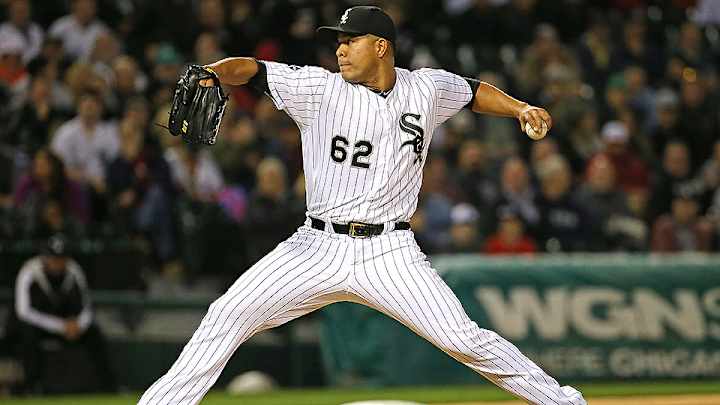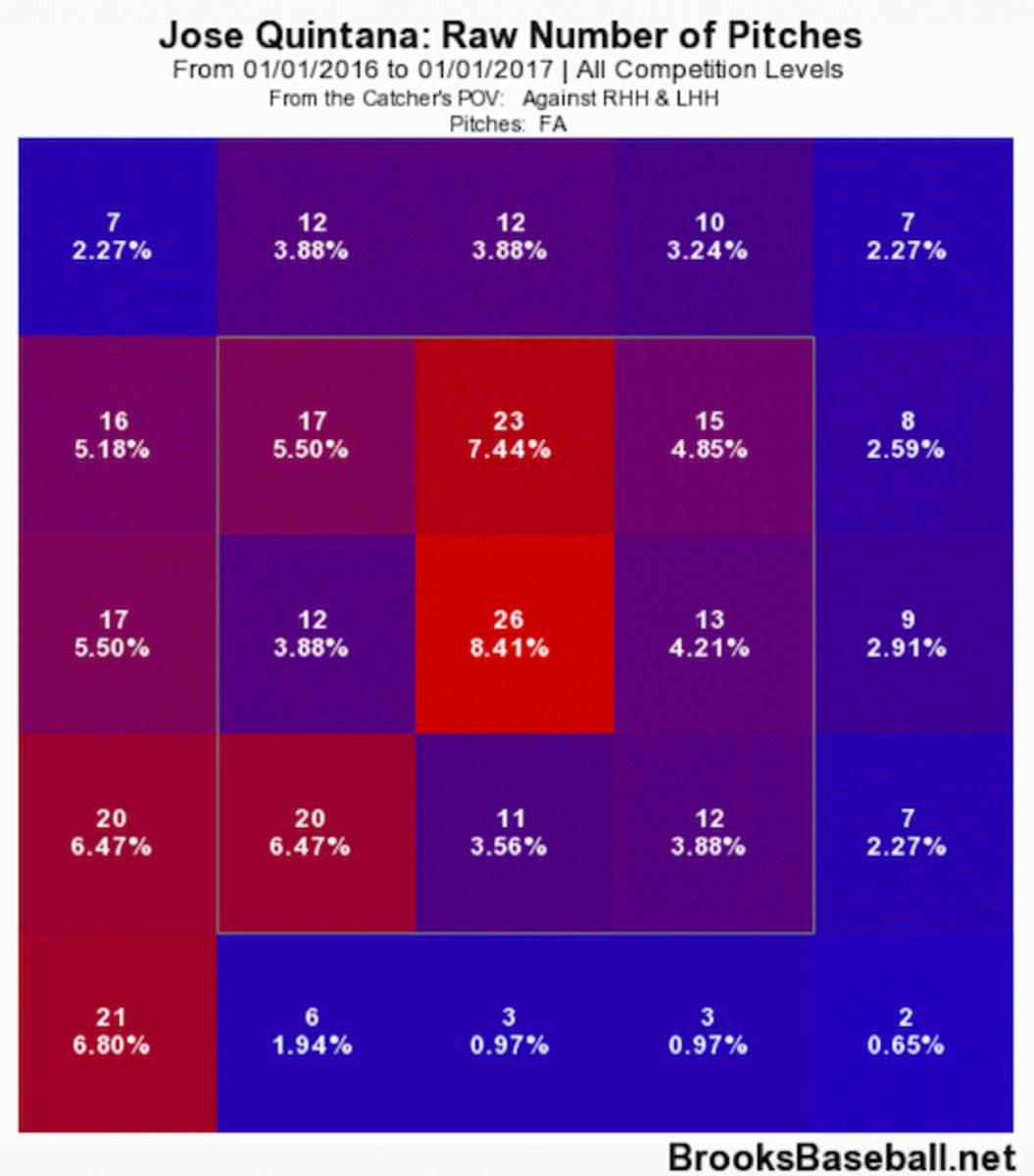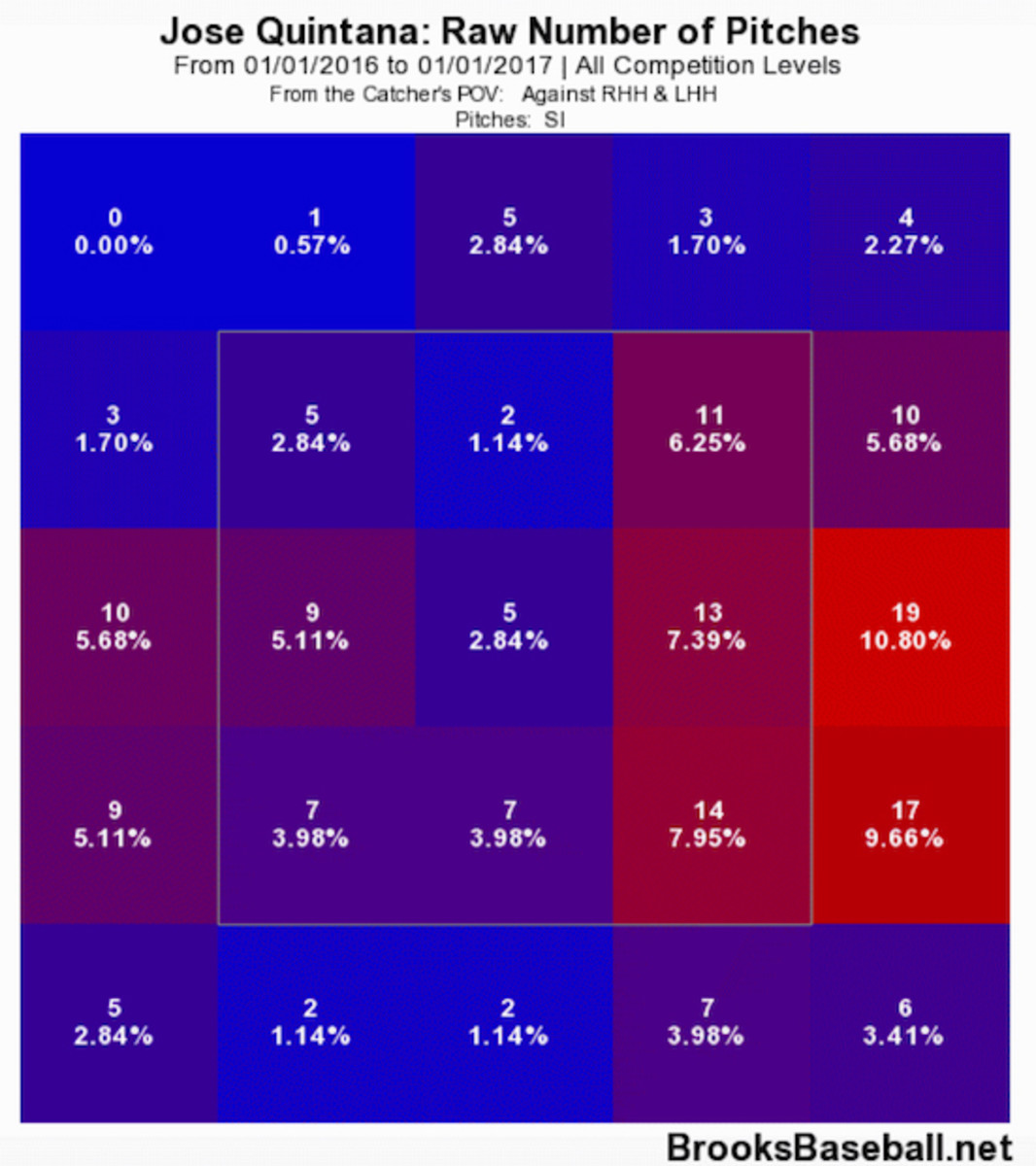Jose Quintana climbing fantasy baseball pitching ranks with hot start

Get all of Michael Beller’s columns as soon as they’re published. Download the new Sports Illustrated app (iOS or Android) and personalize your experience by following your favorite teams and SI writers.
Two aces took the mound in Chicago on Sunday. On the North Side, Cubs’ Jake Arrieta struggled in a no-decision against the Nationals, leaving the game in line to suffer his first regular season loss since last July. Ten miles south, a certain White Sox lefty dominated yet another opponent. This time it was the Twins, a relatively punchless team that he held to one run on six hits in seven innings, striking out five and walking one to move to 5–1 on the season.
That lefty is Jose Quintana. Not only does he complete one of the best starting pitcher combos in the league with Chris Sale, but he’s turning himself into a legitimate ace, from both the real-life and fantasy perspectives.
Quintana has been something of an underappreciated pitcher since becoming a fixture in the White Sox rotation in 2012, but he’s been well known in the fantasy community, turning in useful seasons in each of the last three years. This season, however, his inexorable climb toward Sale’s perch seems to be reaching its apex.
Fantasy baseball Waiver Wire: Byung-ho Park is not going to slow down
Quintana entered the 2016 season with a well-defined book. He threw at least 200 innings every year from 2013 through ’15, totaling a 3.40 ERA, 3.27 FIP and 1.25 WHIP in those three seasons. For each individual season, his ERA was never better than 3.32 or worse than 3.51. His FIP range was from 2.81 to 3.82, while his WHIP was between 1.22 and 1.27. For all intents and purposes, Quintana was the same effective, good-but-not-great starter for three years.
All that has changed this season. After shutting down the Twins on Sunday, the 27-year-old Quintana sports a 1.38 ERA, 0.99 WHIP and 42 strikeouts against nine walks in 45 2/3 innings. His strikeout rate sits at 24%, which would easily best his career high of 21.5% if it held for the entire season. He’s getting more weak contact than ever before, and it owes in large part to improved command and performance of his two most fundamental pitches: the four-seam and two-seam fastballs.
• PIERCE: Cubs making history and earning believers with red-hot start
Quintana has always thrown both the four- and two-seamer, though he has introduced more of the latter over the last two seasons. He threw a cutter when he first broke into the league, but largely scrapped that in 2013, making the two-seamer a real feature of his repertoire last year. This season, his four-seamer has a usage rate of 41.3%, while the two-seamer sits at 23.5%. As you’d probably guess, he uses the two-seamer, with its natural tailing action to his arm side, more against lefties, while favoring the four-seamer against righties. He does, however, use both pitches against hitters on both sides of the plate.
Everything about those two offerings has improved this season. Quintana is getting more empty swings than ever with the four-seamer, running the pitch’s whiff rate to 10%. Hitters have managed to hit .194 with a .222 slugging percentage against the four-seamer, and .185 with a .296 slugging percentage against the two-seamer. Below are zone profiles for the two offerings, with the four-seamer coming first.


Quintana isn’t afraid to throw either pitch for a strike, and that’s putting hitters on the defensive. You can also see, from the hot zones for the two-seamer, that he has absolute command over that pitch. As long as he can live inside to lefties and outside to righties with the two-seamer, he’s going to get a lot of weak contact when he throws it. According to Pitch F/X’s pitch values, Quintana has had the league’s third most valuable four-seamer and seventh most valuable two-seamer this season.
The calling card, however, has always been the curveball. For more on that, let’s bring in David Ortiz as an unfortunate bystander.
That was just one of the nearly 200 curves Quintana has thrown this season, but it’s a great illustration of what’s working for him this year. His curveball is the one pitch on which he’s getting fewer empty swings than usual, with a whiff rate that is down at 7.4%, compared with a career rate of 12.6%. The pitch has resulted in a strike of any kind—swinging, looking or foul ball—28.4% of the time this season, which is right in line with the pitch’s strike rate for Quintana’s career (28.5%). And yet, he’s getting fewer whiffs and foul balls with the pitch this year. The share of taken strikes on the curve has skyrocketed, and that has helped make Quintana’s curve one of the most confounding in the majors.
Even with Quintana pitching as well as he has this season, he might be no better than the third-best pitcher in Chicago. But he could end this season as a top-10 fantasy starter.
Pitchers to watch this week
Patrick Corbin, Diamondbacks
Corbin had his best start of the season his last time out, tossing seven shutout innings against the Braves with five strikeouts. That, of course, isn’t exactly the toughest test a pitcher can face. Corbin has been among the most disappointing pitchers this season, registering just three quality starts in seven outings. He’ll have his hands full when he takes on the Giants in Arizona on Saturday.
Max Scherzer, Nationals
Buy, Sell, Hold: Can Detroit’s Nick Castellanos keep up hot start?
Scherzer seemed to figure some things out two starts ago when he threw seven shutout innings with nine strikeouts in a win over the Cardinals. Then came a matchup with the Cubs. Scherzer ended up having one of the worst starts of his career, allowing seven runs on seven hits, including four homers, in five innings. He won’t be the last big-name pitcher to struggle against the Cubs this year, but it was far from encouraging to see him have such a bad outing after his best start of the season. He’ll have another tough assignment on Wednesday when he takes on the Tigers.
Matt Harvey, Mets
Harvey gave his fantasy owners reason for optimism on Sunday, striking out 10 batters and allowing two runs in six innings in a win over the Padres. He still hasn’t made it though seven innings in any start this season, and has completed six in just three of his outings, but he finally looked good facing the same batters for the third time in the same game. His velocity was strong all game, something that had been an issue for him though April. It’s possible he has turned a corner, though we won’t really be able to evaluate that until he makes a few more starts. Harvey will next take the ball on Friday against the Rockies in Colorado.
Ian Kennedy, Royals
The 30: Starting pitchers in focus for Week 5 MLB power rankings
Kennedy spun another gem on Saturday, shutting out the Indians for seven innings while striking out six and giving up just four hits. Kennedy was supposed to be a staff filler for the Royals this year, but he has already turned himself into one of the team’s most reliable starters. He has a 2.13 ERA, 3.60 FIP, 1.08 WHIP and 35 strikeouts in 38 innings. We’ve seen this from Kennedy before, and there’s little reason to believe he will be more than a top-40 starting pitcher for the rest of the season, but it’s looking like he can be a backend starter in all fantasy formats. His next turn comes on Thursday at Yankee Stadium.
Francisco Liriano, Pirates
After three straight bad starts, Liriano has had a couple of strong outings in his last two trips to the mound. First, he allowed one run on five hits while striking out six in a win over the Reds. On Friday, he dominated the Cardinals, fanning 10 while surrendering just two runs in seven frames. He’s still dealing with some control issues, but that’s just the price of doing business with Liriano. He also has 39 strikeouts in 35 innings, and has enough in his arm to be a top-25 starting pitcher. His next start is Wednesday in Cincinnati.
• CORCORAN: Chapman’s return not enough to turn around Yankees
Prospect watch
Jameson Taillon, Pirates
We’ve looked at Tyler Glasnow in this space a few times this season, but he’s not the only Pittsburgh pitching prospect setting himself up for a promotion. Taillon missed the last two seasons because of Tommy John surgery and an inguinal hernia, but he’s back and just as good as he was when he was roundly seen as a top-20 prospect before hurting his arm. In 30 1/3 innings this season, the 24-year-old has a 1.19 ERA, 0.76 WHIP and 26 strikeouts against just three walks. His fastball still sits in the mid-90s, and his curveball will immediately be a weapon in the majors.
Glasnow will likely get the first shot to crack into Pittsburgh’s rotation, but Taillon can’t be that far behind. Remember, he was right on the cusp of making the majors before he tearing the UCL in his right elbow, and he has gotten himself all the way back to that point. With Jeff Locke and Jon Niese both struggling, there could be room for both prospects in the rotation sooner rather than later. Glasnow should already be owned with him pounding on the major league door, but Taillon is out there for the taking in almost all fantasy leagues. He’s the next prospect to target for a stash.
GIF of the Week
Clayton Kershaw and Troy Tulowitzki are very familiar with one another from their shared days in the NL West. Judging by this at-bat, Tulowitzki likely doesn’t miss him very much.
Two-start pitchers
- Stephen Strasburg
- Jose Fernandez
- Corey Kluber
- Jon Lester
- Drew Smyly
- Jacob deGrom
- Masahiro Tanaka
- Sonny Gray
- Steven Matz
- Felix Hernandez
- Kevin Gausman
- Matt Moore
- Joe Ross
- Hector Santiago
- Aaron Sanchez
- Jose Berrios
- Adam Conley
- Mike Fiers
- Trevor Bauer
- Chris Devenski
- Scott Kazmir
- Anibal Sanchez
- Michael Fulmer
- Chris Young
- Kris Medlen
- Miguel Gonzalez
- Matt Wisler
- Henry Owens
- Clay Buchholz
- Colby Lewis
- Colin Rea
- Tyler Wilson
- Mike Leake
- Tyler Chatwood
- Ivan Nova
- Rubby De La Rosa
- Cesar Vargas
- Jon Niese
- Robbie Ray
- Alex Wood
- Dan Straily
- Jake Peavy
- Matt Cain
- Adam Morgan
- Wily Peralta
- Zach Davies
